BLW Feeding Schedule: First 10 Days of Baby-Led Weaning
- SCHEDULING foods and why you don’t need to alter your baby’s infant milk schedule or nap schedule for the first few weeks and even moths of baby-led weaning
- CHOOSING FOODS - how to use Katie Ferraro’s 5-STEP FEEDING FRAMEWORK to select 5 new safe BLW foods for your baby to try each week. Learn more here.
- WHAT COUNTS - what if my baby doesn’t chew or swallow the food? Does that count?
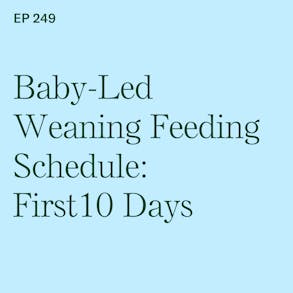
LISTEN TO THIS EPISODE
Episode Description
Which foods should I start with for baby-led weaning? What are the best FIRST FOODS for my baby? Babies can eat so many more foods than we give them credit for and in this episode, I’m sharing some tips for how to select the first foods you offer your baby.
Links from This Episode
- Baby-Led Weaning with Katie Ferraro program with the 100 First Foods™ Daily Meal Plan, join here: https://babyledweaning.co/program
- Baby-Led Weaning for Beginners free online workshop with 100 First Foods™ list to all attendees, register here: https://babyledweaning.co/baby-led-weaning-for-beginners
Other Episodes Related to this Topic

Latest Episodes
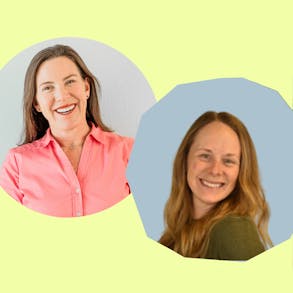
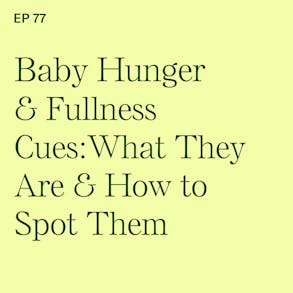
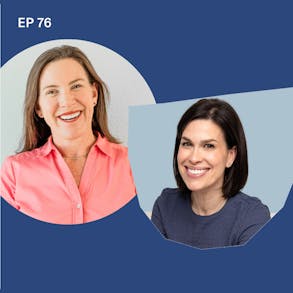
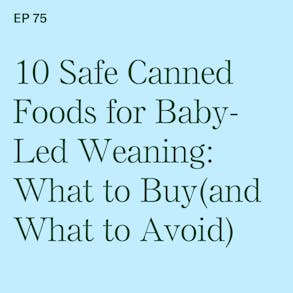
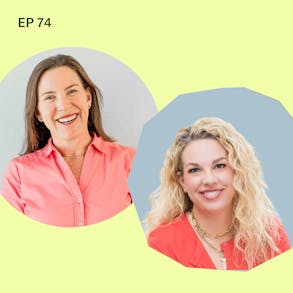
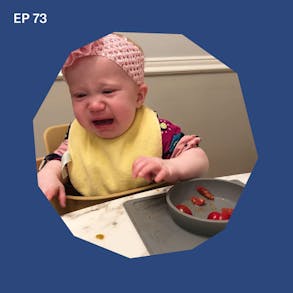
Katie Ferraro (0s):
All right. Quick pulse check. Are you feeling okay about baby Led Weaning a little nervous about this transition or you may be interested in BLW, but not entirely sure if this is the approach for you or maybe you started baby Led Weaning, but you're feeling stuck or you're going to give up because you're not sure if you're doing this right. Don't give up. I have a brand new one hour comprehensive online video training for you called BABYLED WEANING FOR BEGINNERS. It's totally free. And I think it's going to ease a lot of anxiety for you. I just redid this free training. It's packed with videos and visuals on how to safely prepare BLW foods and what the first few days it looks like and how to reduce choking risks. Plus everyone on this free workshop gets a copy of my 100 FIRST FOODS LIST.
Katie Ferraro (41s):
So you'll never run out of ideas about what to feed your baby next. You can get signed up for this week's video workshop times at https://babyledweaning.co/. If you've got one hour to dedicate to learning about BLW, this is the training for you. https://babyledweaning.co/ has this week's workshop times. And don't forget you also get that 100 FIRST FOODS list from this free training. And I hope to see you there. And ask for those first 10 days, especially with the scheduling stuff, I recommend don't move your milk's schedule. Don't move your nap schedule. Reality is your baby is not going to be eating much, but the foods that you pick do matter. So here's an easy way to plan out those first 10 days. Hey there, I'm Katie Ferraro, Registered Dietitian, college nutrition professor, and mom of seven, specializing in baby led weaning.
Katie Ferraro (1m 23s):
Here on the baby led weaning made easy podcast, I help you strip out all of the noise and nonsense about feeding, leading you with the competence and knowledge You need to give your baby a safe start to solid foods using baby Led Weaning. Well, Hey guys, welcome back. Today, we're talking about the first 10 Days of Baby Led Weaning and dive in into some of the feeding schedule stuff. Whenever we do episodes about schedules, parents love schedules. I don't know about you guys. Like I didn't have a schedule with my oldest and then my next babies were quadruplets followed by a set of twins after that.
Katie Ferraro (2m 4s):
And then after having multiples, I was like, how did I ever live without a schedule? And so the point of this episode is not to force you into having a schedule, but just to kind of give you a framework to guide you for those first few days. So you walk away feeling like you've had some modicum of success when starting cause I don't want you to give up on baby Led Weaning. Kind of doing a little bit more of the starter stuff on the podcast. This month, that Monday episodes that I release are these mini baby Led Weaning and Training episodes. And the Thursday ones are always interviews with other feeding experts. So the last mini training I did was two episodes ago, 247. It was three signs that BLW is going well for your baby.
Katie Ferraro (2m 45s):
I'm just really trying to lean into the whole positive approach to baby Led Weaning. I know some parents like baby led weaning is so judgy and it's just people telling you what not to do. And it's been my goal ever since I started working exclusively in baby led weaning over six years ago was to be a force and a voice for the positive things your babies can eat. And so I want to focus on the first 10 days just so you know what to expect and what I'm actually going to do in this episode is shared the exact process that I went through in helping baby Brayden, who is a baby of my friend, my new friend, Ashley here in my hometown of Poway, California, who I'm working with to help her baby start the first 10 Days of Baby Led Weaning. So I do the 100 FIRST FOODS approach, which many of you know I created back in 2016.
Katie Ferraro (3m 28s):
It's my proprietary approach to starting solid foods safely with baby Led Weaning. And I love to document, especially the first 10 days. I'll kind of explain what the first 10 days might look like in today's episode. And I always like to start these little episodes, the training ones with the BLW tip of the day, do not expect your baby to eat anything or very much at the beginning and do not get dejected. If you feel like your baby is not eating when you start solid foods, okay, that is not the point. We're gonna talk about what our goals will be for the first 10 days, but it is not to measure dietician moms and talking to you. We do not care about how many calories the baby's eating. We do not care about the milligrams of iron. We do not care about the ounces or the weights.
Katie Ferraro (4m 10s):
It doesn't matter. Babies need lots of time to learn how to eat. And we do not want to stress ourselves out during this important transition, especially during the first 10 days. And hang tight because I'm going to be sharing that exact process that I go through to pick the first 10 foods for Baby Led Weaning. So I want to tell you guys a quick story. I remember when I started baby Led Weaning with my quadruplets. I had struggled a lot with spoon-feeding my oldest daughter. And I remember like when the quads were ready to start, I waited until their six month adjusted age. And then it was like, oh, what do I do? Like I just put the avocado out there and I go back and I watched the videos of the first few days of solid foods with them. And I was like, I had no idea what I was doing, but then they also had no idea what they're doing.
Katie Ferraro (4m 51s):
So just remember your baby also doesn't know how this is supposed to go either. So you're both here learning together. And I was just recently watching some of those first few days of videos and I just kept offering the same food over and over. And I was like, oh, it's kind of a missed opportunity there because there's lots of other foods Babies can eat besides avocado, banana, and sweet potato. And I say that a little tongue in cheek, but to be honest, we do encounter a lot of parents who just do those simple starter foods, avocado, banana, and sweet potato, over and over and over again. Remember those foods don't have iron, those foods don't have different texture opportunities for your babies. Those are not the allergenic foods. Like the simple starter foods are fine for the first three days, but we really want to keep you on that trajectory of trying one new food a day, every little baby step building towards having your baby eat a hundred foods before they turn one.
Katie Ferraro (5m 36s):
So for today's episode, going through the first 10 days of baby Led Weaning, I want to share some tips about scheduling some tips about the framework of how to pick the foods that you offer. And then some kind of afterthoughts, like as you go through each day, what to kind of look back on, and reflect about before you move forward to the next day with the ultimate goal here being to have you not give up with led weaning. Cause if your baby is six months of age and sitting up on their own, relatively unassisted here, maybe can do this. And I want to see you succeed with Baby Led Weaning. All right. So let's start with some of the schedule stuff. I had a mom who was on my office hours today, and she's like, my baby's only four and a half months of age, but I'm learning everything I can. And inside of my baby led weaning digital program, there's a whole section on getting ready to start solid foods.
Katie Ferraro (6m 19s):
So for parents of babies who are four and five months of age, there still are things you can do to get ready, but we just don't offer anything except infant milk until after the six month mark. And so this mom was particularly nervous about what to do about milk feeds because she said I'm exclusively breastfeeding four and a half months in. I was like, congratulations. She said, what do I need to change? My tip for you is when it comes to starting solid foods, don't change anything about your milk schedule when your baby is six months of age and don't change anything about your nap schedule. Okay, I know you've worked very hard to get your feeding schedule down for infant milk. You worked very hard to get your sleeping schedule down. And the reality is is that starting solid foods really shouldn't and will not interfere with any of that. Because again, there's hardly any intake going on. All you need to do for your schedule is to build in one to two, 20 minute periods each day, where you can try solid foods.
Katie Ferraro (7m 6s):
So my general rule of thumb is that for Baby Led Weaning, I like to see babies eating one to two times a day at six to seven months of age. You can do more than that if you're up for it, but for a lot of parents say that's enough. So don't worry about switching your schedule all around in those first few days because your baby is just getting, you know we're at the very, very starting stages here, just getting familiarized with food. There's hardly any intake that's going on. You might also be interested in episode 185. I did a whole episode called 6-7 Months Old Babies: Sample BLW Feeding Schedule. I share a lot more schedule related stuff that's relevant to the six and seven month old babies. In that episode, again, that's episode 185, Casey, you got the schedule stuff down. You don't make any changes to naps and don't make any changes to milk. Now, what foods are you going to choose for baby Led Weaning.
Katie Ferraro (7m 48s):
Okay. I want you to not fall into the simple starter food rut, where you just do avocado, sweet potato, banana over and over, cause you don't know what other foods to feed. So I created a five step feeding framework. This is kind of the framework for my whole a hundred FIRST FOODS approach. And we introduced one new food a day and five foods a week. So I always say that I kind of think of baby led weaning like my job. I have to work five days a week. I'm going to work five days a week to get my baby to try new foods. And so the five step feeding framework is built around the five different categories in the a 100 FIRST FOODS list. So there's 20 foods divided amongst five categories, and those are the fruits, the vegetables, the starchy foods, the protein foods and the allergenic foods. So generally on Monday we start one new food from the fruit category, Tuesday, one new fruit from the vegetable category, Wednesday, one new food from the starch category, Thursday, one new food from the protein category.
Katie Ferraro (8m 38s):
And then on Friday I do the allergenic food. I do the allergenic food two times on Friday, two times on Saturday and two times on Sunday with no other new foods across the weekend. Okay. That's because we're building in a pad there to observe for any potential reactions to the allergenic food. But you do continue to offer the familiar foods from previous days across the weekend. And at the end of the weekend, your baby has tried that allergenic food about six times, okay. We know that babies will not react to the food on the first exposure. It'll be on the second or subsequent. They're going to react. It will likely happen over the weekend, but if not, you know, some babies could react on the seventh eighth. We had a mom in our program last week who had on the 20th time, her baby tried eggs, started having a severe allergic reaction. So just be aware that it could happen at any time, but you want to introduce these allergenic foods early and often.
Katie Ferraro (9m 22s):
So this framework allows you to move through the different categories of foods, with different textures, with the different nutrients, right? Cause fruits and vegetables are great, but you know, I said earlier, they don't have any iron. They are not the allergenic foods. They don't have any zinc in them. They're kind of all the same texture in many regards. So we like fruits and vegetables cause the vitamin C that helps your baby absorb the nutrition from other food groups, but they're not complete in and of themselves. So if every week you can do these five new foods, you're not only getting the benefit of different food groups and different colors. You're getting different tastes. You're getting different textures. You're getting different types of nutrition. And you're working in the allergenic foods. If you do five new foods a week, it's 20 foods a month and in five months, your baby has had a hundred foods. So for this new baby that I'm working with, baby Brayden was just kind of planning the menu for the first 10 days of Baby Led Weaning.
Katie Ferraro (10m 7s):
So for the first two weeks, I feed five days a week. And I usually do that cause like in case I miss a day or need the weekend to catch up on it or it didn't go so well, it's nice to not have to feel like the pressure of doing this seven days a week. Can you do more than one food a day? Absolutely. If you want to, I just advise against doing more than one allergenic food at once. Cause you really want to be able to observe for any potential reaction. And if you tried two new allergenic foods at the same time, how would you know what the baby reacted to? Right. So in the context of baby Brayden, who's this new baby girl that I'm working with at the time of this recording, I'll be starting week one next week on Monday with her. So the mom will come over and I'll, we'll pick a new fruit. Okay. And then kind of plan the whole menu with our intern Tessa right now. So what I did was I looked across the a 100 FIRST FOODS list, looking for foods that are in season that I can get right now easily and affordably.
Katie Ferraro (10m 54s):
And then I'm also, especially for starting out solid foods. I'm always looking for the foods that I can easily prep so that they're soft and I can cut them into pieces about the size of my adult pinky finger. Hey, there are a few foods on the a 100 FIRST FOODS list. And I explained this inside of my Baby LED WEANING FOR BEGINNERS workshop, but that we wait on feeding the baby until they're older. Okay. So Babies can eat almost all foods. And I really tried to show that across all of my content is that, listen, I can take almost any food from this a hundred FIRST FOODS list and make it work early on. But there's definitely some foods that work better than others. And the ones that you can get into strips about the size of your adult pinky finger, so starting with the fruit on Monday, Mellon. Okay. So Mellon is on the 100 FIRST FOODS list. It's very easy to get melon into soft squish test passable strips, meaning that if I push the strip of the melon between my forefinger and my thumb, it there's a lot of give there and it doesn't snap or break.
Katie Ferraro (11m 44s):
And even if the mellon is not ready yet, I can poach those small strips of Mellon to make them soft enough so that they are fork tender and the baby can safely pick them up and feed them. Okay. I'm also going to be doing for the second day for vegetables. I want you to do bell pepper. Okay. I see a lot of unsafe bell pepper feeding practices, especially on social media, babies are eating raw bell peppers. Okay. Raw bell peppers are hard and crunchy and crispy and they are not safe for early eaters to eat. So with the bell pepper, I'm going to be showing how you can roast your own bell peppers and easily remove this skin and then cut them into strips. That's kind of a pain in the neck. So you also get some jarred, low sodium bell peppers. And I'm also going to be showing how to make a red bell pepper sauce, a romesco sauce. Now romesco traditionally has almond in it, which is one of the allergenic foods.
Katie Ferraro (12m 27s):
So for this particular baby, I wouldn't do the almond because I'm not ready to do the allergenic foods yet. I certainly could if I wanted to on day two, but I like to kind of go food by food and follow the framework. So I'll be doing bell pepper on day two. Okay. Then for day three, okay, I need starchy food. And I'm looking through the list of whole grains. Okay. There's lots of different whole grains that Babies can eat. I'm going to pick one from my whole grain list, which is a whole grain called freekeh. It's a little on the weird side parents. A lot of times like Katie, I hate the wacky whole grains on your 100 FIRST FOODS list. But what it really does is cause you to branch out and try different whole grains, which are very valuable sources of iron. We sometimes don't give a lot of credit to the plant foods that have iron, but the whole grains do. And I don't want you to get stuck in that pasta, potatoes, and rice rut, where you don't know any other carbs to feed your baby besides that.
Katie Ferraro (13m 10s):
So we're getting making freekeh. For day four, I always like to do a protein food. I always try to start with a meat. I have 10 animal foods and 10 plant foods on the a 100 FIRST FOODS list. This family eats meat, so mom is totally okay with baby Brayden trying some meat. And so we're actually going to do rib meat. Okay. I'm going to demonstrate the differences between pork ribs and beef ribs, show some country-style ribs, which are actually a really good high fat meat food. And we're gonna make nice softer shreddable strips of meat with a lot of low sodium broth that the baby can pick up and feed to herself. And then on day five, we're going to do the first allergenic food. I like to do either milk or egg or peanut early on, because other than the three most common pediatric food allergies, but this baby's already had formula. So she's already been exposed to cows milk, and I'm actually going to go with egg because once you have egg down, you can kind of use it to help other foods on the a 100 FIRST FOODS list, especially the grain foods kind of stick together more easily, If you're making little patties or fritters and very, very simple recipes.
Katie Ferraro (14m 3s):
And we generally don't do elaborate combination food recipes early on in Baby Led Weaning, but I want to do egg as her first allergenic food. And I'm actually going to be showing how to do steamed egg cause I normally do fried egg strips and that's perfectly fine, but I want to demonstrate how you can do steamed egg to make a nice soft egg. So if you guys like, like the egg white bites or the egg bites that they have at Starbucks, I love those. And I've been working on perfecting how to make them at home because I'm tired of paying for them at Starbucks. So I'm going to adapt that and make kind of a nice, soft steamed egg that the baby can eat. And that will be our allergenic food for the first week. And then I'll make a lot of extra so that the baby can have a couple more portions of it over the weekend. And the mom will work on doing that over the weekend and then come back for week two. For week two, we're going to start the process all over again, go back to fruit.
Katie Ferraro (14m 46s):
I'm actually going to be doing Kiwi for this baby. So I have both golden Kiwis and green Kiwis and showing you how to kind of cut the Kiwi in the right way. I know it's hard to describe on a podcast, so a lot of this will be on YouTube. I'll put a lot of it on Instagram, then also the inside of my program, my a 100 FIRST FOODS digital program. For the second vegetable, we'd be doing mushrooms and experiment a little bit with portabella mushrooms and getting them nice and soft. So, you know, the rubbery texture of mushrooms is cool, but it's a little bit hard for early eaters. So we're going to work on some different ways to soften mushrooms without salt. On date eight, we'll be doing rice as a different type of grain from the starchy foods list. Many food cultures rely on rice. Rice in moderation in small amounts is perfectly safe for babies. We just did an episode about Arsenic in Baby foods.
Katie Ferraro (15m 28s):
I had Charlotte Brody and Jane Houlihan from Healthy Babies Bright Futures on. They were talking a lot about Arsenic in Baby foods. And we're talking about how as a crop rice has more of a tendency to take up more Arsenic than other plant crops do. And yet they were sharing the technique of how to cook your rice in a pasta water style bath. So instead of just putting the exact amount of water that you want, the rice to absorb, you cook it in a lot more water like you would with pasta as a way to leach out some of the arsenic. And so I'm going to be experimenting with some kind of different cooking methods for rice, and then working that back into little rice logs that the baby can pick up and feed to herself. Okay. And then for the second protein, I'm gonna switch from an animal we did repeat on week one, I'll do a plant protein.
Katie Ferraro (16m 9s):
We're gonna do Pinto beans showing you how to make some baby Led Weaning, re-fried beans. And we can do that off of the preloaded spoon or babies tend to pick it up with their hands. And then for the 10th day, which is the fifth day of the second week, I'll pick another allergenic food. I like to kind of pop all over the allergenic foods category, just showing different ways that early eaters can try these foods. I'm actually going to be doing crab of. I know a lot of families that do crab and lobster credit towards the end. A lot of families will do lobster as the hundredth food to kind of like a celebratory food. I'm going to do crab a little bit earlier on and I still haven't figured out exactly what recipe I'll be sharing with that. But if you want the recipes for all of these 10 days, I'm sharing them on my email list. So I'll put a link to that in the show notes for where you can get signed up for the weekly.
Katie Ferraro (16m 50s):
Nice and almost daily emails with baby led weaning trainings and tips and lots of other content. But on Sunday, I always do a summary, what we did for the week and I include a baby led weaning recipe. But for these 10 days for baby Brayden, we'll be sending out two weeks of emails one day for each food, with the recipe in that it's all shared on email. So make sure you click the link in the show notes to get signed up. So you're getting the email so you can get all of these recipes. Hopefully you guys can follow along on Instagram. We'll be sharing a lot in stories. We'll be doing a lot of YouTube videos out of baby Brayden's first 10 days as well. And if you don't have the a 100 FIRST FOODS list, I want you to be able to pick the 10 foods that work for you for the first 10 days. You can grab that list on my free online workshop called Baby LED WEANING FOR BEGINNERS is all about how to get your baby to eat a hundred foods before turning one, without you having to spoonfeed purees or buy pouches.
Katie Ferraro (17m 39s):
And then you can sign up for this week's workshop times and grab your copy of that a 100 FIRST FOODS list. So you can kind of be following this framework. I also go through the framework and way more depth than that video training. So the Baby LED WEANING FOR BEGINNERS workshop is a one hour video training and that's at babyledweaning.co. So again, head to babyledweaning.co, if you want some more info about how to put the first 10 days into practice, it's a little bit easier to share on the video training. Cause I show you the actual foods for the first 10 days. But I want you to think too, as you've moved through the first few days of baby Led Weaning about, you know, sometimes parents ask what counts as a serving. I always say to the moms and dads and caregivers, if you make it, it counts, okay, but you're continually going to be reintroducing the familiar foods from previous days to your baby.
Katie Ferraro (18m 20s):
So it's not like you just do it once and then you're done with it. And inside of that video training, I show you how to build a balanced plate for your baby and be offering one new food a day. But at the same time being continually reintroducing the foods from previous days. So if you make it, it accounts, don't give up. After those simple starter foods, I always suggest planning on a Sunday or the over the weekend for what the five foods that you'll have next week are I like actually doing two weeks at a time because then it makes me kind of think, gosh, right? Do I even have those foods on hand and order them or make sure I get them from the grocery store? Because if you don't have them in your house, you can't make them. So once you get through the first 10 days of baby Led Weaning, you guys are 10% of your way to 100. So take a second to congratulate yourself.
Katie Ferraro (19m 1s):
Don't get dejected, if your baby's not eating a ton, they are super lucky because you're taking the time to make all these different foods for them and to offer them in a way that's safe. And that takes advantage of their developmental abilities to feed themselves. So good luck with the first head Days of Baby Led Weaning, I'll be linking all of the resources I mentioned in today's episode on the show notes, which you can find at https://blwpodcast.com/episodes/249. See you next step.
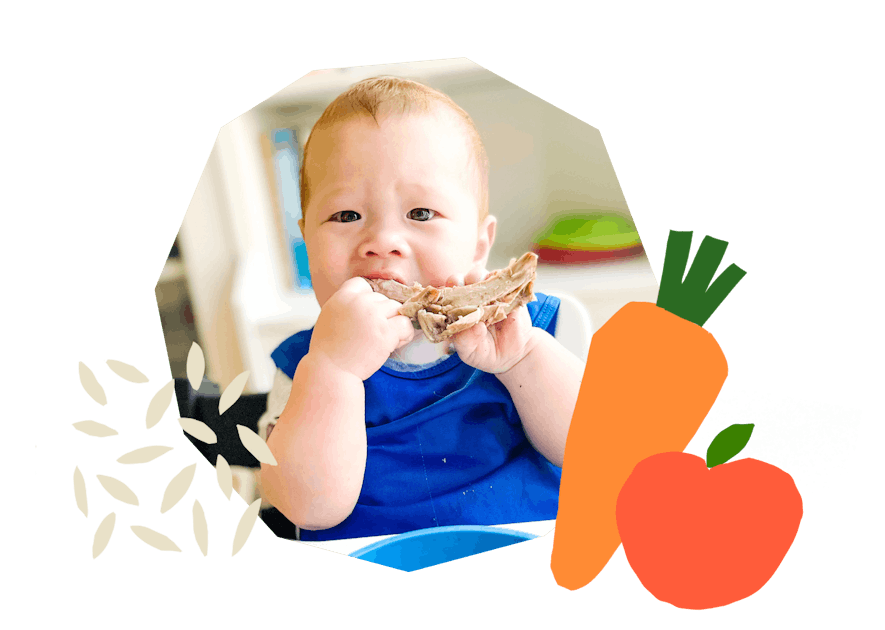
The Program Baby-Led Weaning with Katie Ferraro
A step-by-step digital program for starting solid foods safely and navigating the original 100 FIRST FOODS™ meal plan with baby-led weaning.
 EXPERT-LED, PROVEN APPROACH TO EATING REAL FOOD
EXPERT-LED, PROVEN APPROACH TO EATING REAL FOOD CONCISE VIDEO TRAININGS TO MASTER BABY-LED WEANING
CONCISE VIDEO TRAININGS TO MASTER BABY-LED WEANING 100 FIRST FOODS DAILY MEAL PLAN WITH FOOD PREP VIDEOS
100 FIRST FOODS DAILY MEAL PLAN WITH FOOD PREP VIDEOS
Baby-Led Weaning for Beginners Free Workshop
Is your baby ready to start solid foods, but you’re not sure where to start? Get ready to give your baby a solid foundation to a lifetime of loving real food…even if you’re feeling overwhelmed or confused about this next stage of infant feeding.
Get baby-led weaning recipes and tips delivered to your email inbox.

